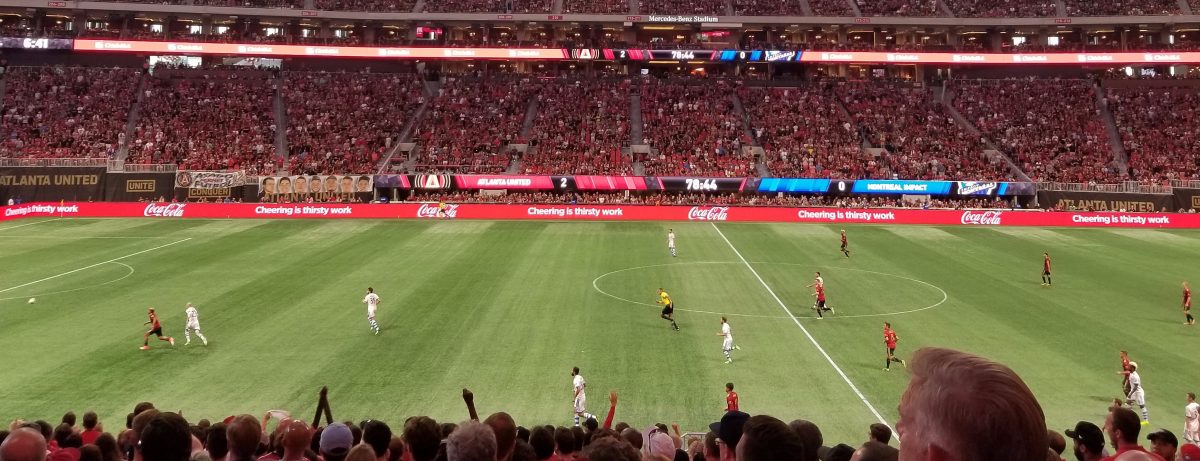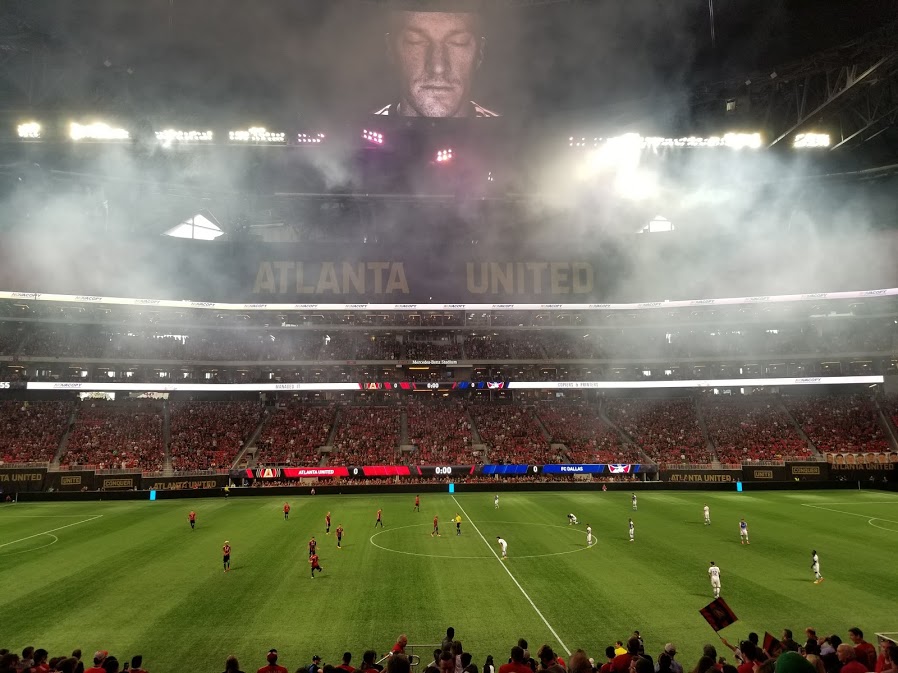I wrote a piece for DirtySouthSoccer, which you can find here, where I update us all on the PACE standings as of Monday 9-25-17. Then I ponder some difficult questions around whether one can rotate the squad when there’s still so much left to play for. #4 comes with homefield advantage in the play-in round, #2 comes with a first round bye. Atlanta are favored to achieve both of these, but the Almiron injury…
Month: September 2017
On MLS Home Advantage and Playoff Structures
Home field advantage is a real thing in sports. And it impacts soccer more than any other major sport. Freakonomics argues that home field advantage is primarily driven by refereeing decisions as the raucous crowds have a conscious or subconscious impact on the referee when he goes to make difficult decisions. In soccer where the referee has greater latitude to make highly judgmental decisions that significantly impact the game, homefield advantage is felt the heaviest:
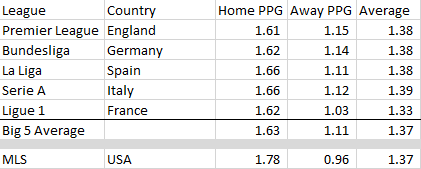
More interestingly, homefield advantage is greater in MLS than in the 5 major European leagues. In the major European leagues, home sides generally average 1.6+ ppg, but in MLS it is 1.8 ppg at home. This is a significant difference. Some have argued that the difficult travel times (unique to the larger US geography) and coach class commercial flights have a big impact here, but personally, I think it’s more likely that a similar homefield advantage exists in America as it does overseas (i.e. one that is primarily determined by important, judgmental referee decisions per Freakonomics), but that the parity of the league amplifies this effect. After all, if there is a very little difference between two teams facing one another on the field, any inherent advantage to the home side will show through more often. And this happens in MLS. And of course, MLS by design is a league of great parity relative to the European leagues. There’s a Salary Cap and some other interesting roster budget mechanisms that I’ve discussed before, several times. A league designed to be competitively even (like some other popular US-based professional leagues) should suffer more from the impact of unconsciously biased referee decisions. Perhaps this is why they are adopting V.A.R. ahead of the rest of the world. A post for another day.
But, here’s what I wanted to talk about: the Playoffs.
This week Sam Stejskal at FourFourTwo reported that MLS is considering an overhaul to the playoffs formatting due to scheduling issues where the FIFA international break slows down the “momentum” of the playoffs between the conference semi-final and final rounds. Currently those rounds are home and home double-legged affairs with away goals being the tiebreaker if aggregate scorelines are tied after 180 minutes plus stoppage. The reported proposal would swap out these double leg series for single elimination games hosted by the higher seeds. Stejskal mentions that the lower seeded team has won 8 of the 12 conference championship series since the current structure was introduced (this seems like a perfectly reasonable outcome over a sample as small as this if you buy that home and homes are mostly fair to both teams). Also posted at FourFourTwo acutally… while I was drafting this paragraph, is this piece by Steve Davis, who mentions that 11 out of 12 single elimination play-in games have gone to the home sides!
It is my opinion that switching to fully single elimination games hosted by the higher seeds would be a mistake because of the significant home field advantage in MLS, which is due to the significant level of parity in MLS (something the league purposefully designed). With teams averaging 1.8 points per game at home during the regular season and less than a point per game on the road during the regular season, these series would become largely “no contests” when that’s not what playoffs are supposed to be (my gut is that they would mirror the 11/12 play-in games going to the home team). Consider how few teams in MLS actually average more than 1.5 points per game (a favorable average) when playing away from home. Below is the full inventory of said teams over the past 5 years:

Also consider, how this stacks up to more traditional “Big 5 European Leagues” with traditionally less parity, in terms of percent of the league that averages 1.5+ ppg when playing away from home:
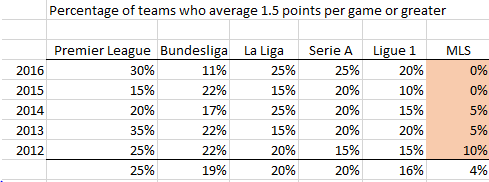
If no teams in your league can average a positive result when playing away, then why would you even hold a postseason in which every single round is laced with the most significant home field advantage observable in sports? It doesn’t make sense to me. Many out there want the team with the better record to be rewarded with an advantage in the playoffs. I understand this sentiment. After all, while playoffs are an exciting way to determine a league champion, the regular season should “matter” – especially in a sport like soccer, where the best leagues in the world determine their champion via a regular season table format. But my answer to these complaints is that first and foremost, the 2 best teams in each conference are absolutely rewarded something valuable, a bye – well earned rest, and the right not to be challenged by the 5th or 6th best teams in the conference. The third and fourth best teams are offered the significant homefield advantage vs the 6th and 5th best teams in the play-in rounds. But once we whittle the playoffs down to the top 4 teams in each conference, are we sure we want to try to reward incrementally different advantages to each of those 4 teams? In a league of parity and where the schedules aren’t balanced and New York Red Bulls and New York City FC have to play each other 3 times a year while Atlanta gets to face DCU (let’s not talk about it), if we were to award the 2nd best team a significant advantage over the 3rd place team in the East, would that even be fair? How certain would we be that the 2nd place team really earned this advantage? And as a reminder, the advantage given to the 2nd place team in this case would be massive based on the numbers mentioned above this post. From 2012-2016 in MLS, teams equivalent to the #4 seed in each conference average 1 point per game on the road against the league as a whole (including the basement dwellers of each conference). In short, it’s stacking the deck too much to let a team averaging 2.3 ppg at home (average top seed home record) host a team averaging 1 ppg on the road (avg #4 seed away record) and have this be the meat of your postseason (conference semi-finals and conference finals).
In summary, MLS created a league based mainly on the traditional American socialist-oligopoly high-parity sports model (NFL, NBA), and not on the free-market model (MLB, EPL, etc). In doing so, the league needs to accept that it values parity, and that having chosen a playoff-determines-champion model, the league needs to accept that it mainly* values the “what-happens-in-the-postseason-is-what-matters” concept. Those two ideas work decently well together, and the main benefit is that the playoffs are interesting because in most postseason games, they offer a visceral and tangible moment to distinguish two good teams that both want to be champion in a mostly just manner. While I understand that it feels right to give a team an edge for success it maintained over the long haul in the regular season, full homefield advantage in a single knockout game is too blunt of a tool to accomplish this, and further due to the nature of the league’s parity and the odd imbalanced scheduling, I’m not sure there’s much between 1-4 that would make me even want to dole out rewards/advantages in the playoffs between those teams. Just let the playoffs be what playoffs are supposed to be, taking the X number of best teams over the course of the year and facing them off against each other to determine who can come out on top when it matters most.
Postscriptum:
I realize that I didn’t address the MLS Cup Final being hosted by the higher seed as well as the play-in games being single elimination games hosted by the 3/4 seeds vs 5/6 seeds in each conference. For the record, it would be ideal to host the MLS Cup Final on neutral ground (like the Super Bowl), but I understand how ticket sales / tv optics impact this decision for a league that’s still trying to establish it’s place. It seems a necessary evil to me to make sure the Final is sold out and packed. Similarly, I think it’s fair to think of the 5th and 6th best teams in a conference as “wild cards” lucky enough to have made it into the playoffs (but also important that they’re allowed a path at all, given a league of high parity demands more teams be allowed entrance into the postseason).
Additional Material on Home Advantage:
- AmericanSoccerAnalysis on Home Advantage and Success Rates
- ASA on Distance Travelled and Home Advantage
- SBNation on Home Advantage across sports
- Freakonomics on where Home Advantage comes from
Sorry for the team-agnostic content this time around. Will try to do a catch up post soon on recent ATL UTD matches… there’s just so many of them, and some of them are weird.
Atlanta United FC 3 – 0 FC Dallas
Chance Dominance & Efficiency in the Final Third
In the first ever soccer match at Mercedes Benz Stadium, Atlanta dominated the score sheet with a 3-0 victory and created their highest single game tally of expected goals (2.8 per ASA) this season. The team held FC Dallas to 0 goals and 1.2 expected goals (this spread is partly luck and partly Guzan). And the resulting 1.7 xGD is the highest winning expected goal difference for the club this season. All this points to dominance by the Five Stripes, and I think that’s probably fair. The box score suggests dominance as well:
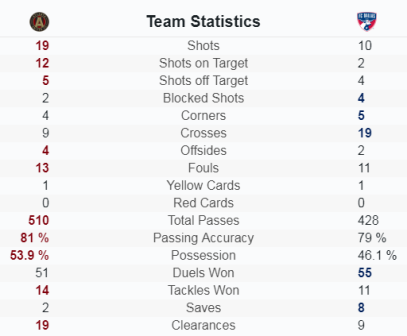
However, I would say as a fan, I only felt comfortable in the second half. FC Dallas’ only two shots on target were two very good chances that Guzan had to make big saves for.

And as dominant as Atlanta were in the end, those types of games will occasionally go south depending on the ordering of events and the direction of some bounces. I’ve included a map of all 5 of FC Dallas’ shots on target and blocked shots. They’re all very good chances, and would’ve altered events.
On the Atlanta side of things, 12 of 19 shots being put on frame is a high number (63% vs the league average 36%). The home side were exceedingly efficient at turning shots into #problems for Jesse Gonzalez. But as I recall, they were also much more efficient at turning attacks into shots (contrast this with away at Orlando where many counters and other attacking moves ended up just shy of registered shots).  Whoscored has Atlanta at 27 touches inside the box, with an insanely high 8 firing within the 6 yard box. While a few of the 19 were from range, 19 shots on 27 touches inside the box feels pretty high to me – it feels *very* efficient. Because of all of this, I would not describe Atlanta’s 25% SOT conversion in this game as wasteful or as evidence of “sloppiness in the final third.” I would say the team were mostly lights out efficient in turning attacks into threats and threats into huge threats. Jesse Gonzalez stood on his head some, but at the same time, even while putting on massive shots and xG numbers, Atlanta still bested the 2.8 expected goals with 3 actual goals. I would say finishing was not a problem in this one.
Whoscored has Atlanta at 27 touches inside the box, with an insanely high 8 firing within the 6 yard box. While a few of the 19 were from range, 19 shots on 27 touches inside the box feels pretty high to me – it feels *very* efficient. Because of all of this, I would not describe Atlanta’s 25% SOT conversion in this game as wasteful or as evidence of “sloppiness in the final third.” I would say the team were mostly lights out efficient in turning attacks into threats and threats into huge threats. Jesse Gonzalez stood on his head some, but at the same time, even while putting on massive shots and xG numbers, Atlanta still bested the 2.8 expected goals with 3 actual goals. I would say finishing was not a problem in this one.
That all being said, while it’s not surprising to hear very bullish talk of the team challenging for a top 2 spot in the east, along with talk that the wider and deeper playing surface has offered us a glimpse at a new normal for Atlanta where they will dominate every away side with pace and tenacity, (inhales) I expect we might see the team be slightly less efficient going forward at turning attacks into shots, slightly less efficient at turning shots into shots on target, and slightly more efficient at turning shots on target into goals (as has been the trend so far this year). I don’t feel too strongly about it. I’m just hesitant to think that what we saw against FC Dallas is what we’ll see going forward because of a bigger field and a slicker surface.
Pressing & Tidiness

These pressing numbers seem fairly standard for Atlanta with the exception that Dallas was slightly tidier than a typical Atlanta opponent. This may have been impacted by the severe game states of Atlanta leading for most of the game and increasing its lead as the game went on. Also both teams played more own-half passes than I’ve been seeing in these numbers. Atlanta’s 225 higher than its season average of 195, and FC Dallas’ 163 higher than Atlanta’s opponents’ average of 126. Perhaps this is the bigger pitch showing up, hard to tell. I thought Atlanta’s press was somewhat more ruthless than these numbers show with several balls won back quickly after a turnover, and quickly converted into through balls and other transition moves.
Atlanta’s defensive actions in the first half (left) and second half (right):
This is somewhat surprising given what I thought I observed which was a press that slowed somewhat in the second. I think in the second what you’re seeing is more counter-pressing — pressing to win the ball shortly after losing it to keep Dallas from countering.
Shape
We saw a return to the more pronounced back-3 shape with Larentowicz eager to join the other centre backs when in possession (LGP and Parkhurst in the left graphic, Jeff in the right).
Asad and Almiron seemed to connect over and over again with great effectiveness on the left. I can’t tell just yet if we should credit the larger pitch or not. It very well could have been the case that they each felt more comfortable on the ball with the defense stretched both laterally and vertically by the speed of Martinez and Villalba (and also Almiron). Jason Poon suggested that Atlanta and Almiron specifically targeted Dallas’ right back Grana. And that might very well have been the case. On the left below is the chalkboard for Garza + Asad, and on the right the map for Almiron, who does seem awfully left-leaning for a central playmaker. Asad drifts inward some but no more than usual. Anyhow, the key passes coming in from that side from these 3 players alone is … it’s high.
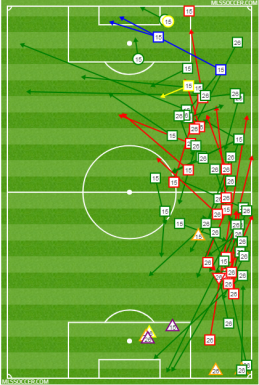 On the right side, there has been some criticism recently that the Garza/Asad dynamic of the fullback stretching the defense wide and the attacking midfielder tucking in wasn’t being replicated to the same degree of success. In this game however, I noticed Villalba tucking in often nicely into pockets between the lines to receive the ball. We don’t see the same degree of advancement from Walkes that we might see from Garza game to game, but the variety in attacking width on the right seemed to work well enough.
On the right side, there has been some criticism recently that the Garza/Asad dynamic of the fullback stretching the defense wide and the attacking midfielder tucking in wasn’t being replicated to the same degree of success. In this game however, I noticed Villalba tucking in often nicely into pockets between the lines to receive the ball. We don’t see the same degree of advancement from Walkes that we might see from Garza game to game, but the variety in attacking width on the right seemed to work well enough.
One last look at the attacking passes for each team. You can really see a contrast in style between the two. The first half below, Atlanta on the left and Dallas on the right:
FC Dallas obsessed with width. Atlanta just killing them from the most dangerous areas. In the second, it’s a little bit more varied as Dallas chased the game.
I’ll have to cut this one off now. Too many games.
In short, this game was a lot of fun. It’s possible the larger pitch is super-charging the team, but I want more evidence before we call that one. Atlanta was extremely efficient at turning attacks into shots, but Gonzalez was also a disruption. Guzan was very good. Atlanta good. Dallas bad.
Atlanta United & MLS Roster Rules: 2018 Salary Cap Scenarios
Just a quick jump post over to DirtySouthSoccer where I wrote a piece about the MLS roster rules and the salary cap, looking ahead to 2018 and wondering what sort of options the front office has to retain the squad as currently assembled. If you like spreadsheets, give it a read, but maybe make a pot of coffee first.
I try to guess at GAM and TAM balances as initially allocated to the expansion clubs plus I guess at undisclosed traded amounts and unconfirmed rumors of future money injections by the league. In the end, if you want to help think through whether the club can sign Garza and/or Asad next year, you’ll need to read most of it.

